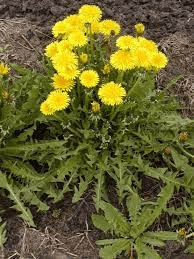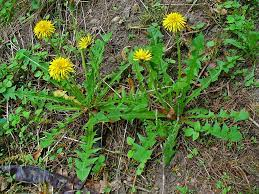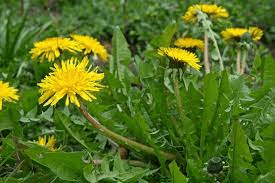The Dandelion, scientifically known as Taraxacum officinale, is a widely recognized and tenacious perennial herb belonging to the Asteraceae family. Originating from Europe and Asia, it has successfully naturalized in many regions around the world.
Often considered a weed, the dandelion is notable for its distinctive yellow flowers, unique seed dispersal mechanism, and a long history of culinary, medicinal, and cultural uses.
Physically, the dandelion is characterized by its basal rosette of deeply lobed leaves that can vary in shape. The leaves contain a milky sap. In early spring to late fall, the plant produces solitary yellow flowers atop hollow stems, with each flower head consisting of numerous tiny florets.
After flowering, the familiar white spherical seed heads develop, commonly known as “blowballs” or “clocks,” which disperse in the wind when the seeds are released.
Culturally, the dandelion has both positive and negative associations. While considered a nuisance in lawns and gardens due to its prolific nature, it has been appreciated for its resilience and is often used as a symbol of endurance and the cycle of life in various cultures.
In some societies, dandelion flowers are associated with childhood and play, as children delight in blowing the seeds and watching them float away in the breeze.
In terms of culinary uses, dandelion leaves are edible and are often included in salads for their slightly bitter flavor and nutritional value. The flowers can be used to make dandelion wine or for various culinary purposes. Additionally, the roots have been roasted and used as a coffee substitute in some cultures.
Medicinally, dandelion has a history of use in traditional herbal medicine. The plant is rich in vitamins and minerals, and its roots, leaves, and flowers have been employed for their potential diuretic, anti-inflammatory, and antioxidant properties. Dandelion extracts are sometimes used to support liver health and aid digestion.
From an ecological standpoint, dandelions play a role in supporting pollinators such as bees and butterflies. The early blooming flowers provide essential nectar sources in the spring, contributing to the overall biodiversity of a given ecosystem.
The Botanical Description of Dandelion
1. Leaves: Dandelion leaves form a basal rosette, characterized by deeply toothed edges and a lanceolate shape. The leaves are hairless and can grow up to 30 centimeters in length.
2. Flowers: The bright yellow flowers of the Dandelion are composed of numerous ray florets. The flowers are borne on a single, hollow stem and open during the day, closing at night or in overcast conditions.
3. Stem: The stem of the Dandelion is smooth, hollow, and contains a milky sap. It rises from the center of the rosette, supporting the solitary flower head.
4. Root: Dandelion roots are long, taproot-like structures that can extend deep into the soil. They are brown or black on the outside and white on the inside.
5. Seed Head: After flowering, Dandelions form a distinctive seed head known as a “clock” or “dandelion clock.” Each seed is attached to a parachute-like structure that aids in wind dispersal.
6. Reproduction: Dandelions reproduce both sexually, through seeds, and asexually, through the growth of new plants from the root. The plant’s ability to produce numerous seeds contributes to its widespread distribution.
7. Habitat: Dandelions are adaptable and can thrive in various habitats, including lawns, meadows, fields, and disturbed areas. They are commonly found in temperate regions around the world.
8. Flowering Season: Dandelions typically flower in the spring and early summer, with the exact timing varying based on geographic location and local climate conditions.
9. Adaptations: Dandelions have evolved adaptations for seed dispersal, with their parachute-like seeds easily carried by the wind. The deep taproot allows the plant to access nutrients from deeper soil layers.
The Geographic Distribution of Dandelion
1. Global Presence: Dandelions are found on every continent, from North and South America to Europe, Asia, Africa, and Australia. Their adaptability contributes to their cosmopolitan distribution.
2. Temperate Regions: Dandelions prefer temperate climates and are commonly found in regions with distinct seasons. They are abundant in meadows, grasslands, and open spaces.
3. Urban and Rural Areas: Dandelions are highly adaptable to different environments, thriving not only in natural habitats but also in urban and suburban areas. They can be found in lawns, parks, and disturbed areas.
4. Altitudinal Range: Dandelions can be found across a wide range of altitudes, from lowland areas to mountainous regions. Their ability to grow in diverse elevations contributes to their global prevalence.
5. Soil Preferences: While adaptable to various soil types, Dandelions prefer well-drained soils. They can be found in sandy soils, loamy soils, and even in disturbed or compacted soils.
6. Disturbed Areas: Dandelions are often pioneer species in disturbed areas, such as construction sites or abandoned fields. Their ability to colonize quickly contributes to their widespread distribution.
7. Invasive Potential: In some regions, Dandelions are considered invasive species, outcompeting native plants and establishing themselves in a variety of ecosystems.
8. Climate Tolerance: Dandelions exhibit tolerance to a range of climatic conditions, from cold winters to hot summers. This adaptability enhances their ability to thrive in diverse geographic locations.
The Chemical Composition of Dandelion
1. Taraxacin: This bitter compound is unique to Dandelion and contributes to its digestive benefits.
2. Sesquiterpene Lactones: These compounds have anti-inflammatory properties and may contribute to Dandelion’s analgesic effects.
3. Flavonoids: Dandelion contains flavonoids with antioxidant properties, helping to neutralize free radicals in the body.
4. Beta-Carotene: Known as a precursor to vitamin A, beta-carotene in Dandelion supports eye health and immune function.
5. Potassium: Dandelion is a good source of potassium, an essential mineral for maintaining fluid balance and supporting heart health.
6. Inulin: A type of soluble fiber, inulin aids in digestion and supports gut health by serving as a prebiotic.
7. Vitamins: Dandelion is rich in vitamins, including vitamin C, vitamin K, and various B vitamins, contributing to overall health.
8. Iron: Dandelion contains iron, which is important for the production of red blood cells and oxygen transport.
9. Calcium: Dandelion provides a source of calcium, essential for bone health and muscle function.
10. Magnesium: Magnesium in Dandelion contributes to muscle and nerve function, blood glucose control, and bone health.
11. Zinc: This essential mineral supports immune function, wound healing, and DNA synthesis and may be found in Dandelion.
12. Choline: Dandelion contains choline, a nutrient important for liver function, brain development, and nerve function.
Read Also: 15 Medicinal Health Benefits Of Spikenard (Nardostachys jatamansi)
The Medicinal Health Benefits Of Dandelion (Taraxacum officinale)

1. Liver Health: Dandelion supports liver health by promoting the flow of bile, which aids in digestion and detoxification.
2. Digestive Aid: The bitter compounds in Dandelion stimulate digestive enzymes, promoting healthy digestion and reducing bloating.
3. Kidney Function: Dandelion acts as a diuretic, supporting kidney function by increasing urine production and promoting detoxification.
4. Anti-Inflammatory Effects: Sesquiterpene lactones in Dandelion have anti-inflammatory properties, potentially benefiting conditions like arthritis.
5. Antioxidant Action: Flavonoids and beta-carotene in Dandelion act as antioxidants, helping neutralize free radicals and reduce oxidative stress.
6. Blood Sugar Regulation: Dandelion may help regulate blood sugar levels, making it beneficial for individuals with diabetes or at risk of insulin resistance.
7. Weight Management: The diuretic and digestive benefits of Dandelion may contribute to weight management and fluid balance.
8. Skin Health: Dandelion’s antioxidant properties may support skin health by reducing oxidative damage and promoting a healthy complexion.
9. Eye Health: Beta-carotene in Dandelion is essential for eye health and may help prevent age-related macular degeneration.
10. Immune Support: The vitamins and minerals in Dandelion, including vitamin C, contribute to immune system function.
11. Bone Health: Calcium and vitamin K in Dandelion support bone health, reducing the risk of osteoporosis.
12. Respiratory Health: Dandelion may have respiratory benefits, helping soothe coughs and alleviate symptoms of respiratory conditions.
13. Anti-Cancer Properties: Some studies suggest that Dandelion may have anti-cancer properties, inhibiting the growth of certain cancer cells.
14. Cardiovascular Health: Potassium in Dandelion supports heart health by regulating blood pressure and promoting proper heart function.
15. Anti-Allergenic Effects: Dandelion’s anti-inflammatory properties may help alleviate symptoms of allergies and allergic reactions.
16. Mood and Stress Support: The presence of vitamins and minerals in Dandelion contributes to overall well-being, potentially impacting mood and stress levels.
17. Urinary Tract Health: Dandelion’s diuretic properties may benefit urinary tract health by promoting regular urination.
18. Anti-Aging Benefits: The antioxidant content of Dandelion may contribute to anti-aging effects by reducing oxidative damage.
19. Menstrual Health: Dandelion’s anti-inflammatory effects may help alleviate menstrual cramps and discomfort.
20. Detoxification Support: Dandelion supports the body’s natural detoxification processes by aiding liver and kidney function.
The Methods of Usage to Achieve the Provided Health Benefits Of Dandelion (Taraxacum officinale)
1. Dandelion Tea: Prepare Dandelion tea by steeping dried leaves or roots in hot water. This method is ideal for promoting digestive health and enjoying the diuretic benefits.
2. Dandelion Tincture: Tinctures are concentrated extracts of Dandelion in alcohol. They offer a convenient way to incorporate Dandelion’s medicinal properties into your routine.
3. Dandelion Salad: Enjoy the fresh leaves in salads to benefit from their nutritional content, including vitamins, minerals, and antioxidants.
4. Dandelion Capsules: Dandelion capsules or supplements provide a convenient option for those looking to incorporate Dandelion into their routine without the taste of tea or tinctures.
5. Dandelion Root Coffee: Roasted Dandelion roots can be ground and brewed as a coffee substitute. This method is popular for its rich flavor and potential digestive benefits.
6. Dandelion Infused Oil: Infuse Dandelion flowers into oil for topical use. This oil can be applied to the skin for its potential anti-inflammatory and skin-soothing effects.
7. Dandelion Syrup: Create a syrup by combining Dandelion extract with sweeteners. This method offers a pleasant way to consume Dandelion for its potential health benefits.
8. Dandelion Smoothies: Add fresh or dried Dandelion leaves to smoothies for a nutrient boost. This method is ideal for those who enjoy the versatility of smoothie recipes.
9. Dandelion Poultice: Create a poultice using crushed Dandelion leaves. Apply it topically to areas of inflammation or skin irritation for potential relief.
10. Dandelion Infused Vinegar: Infuse Dandelion leaves or flowers into vinegar for a tangy dressing or marinade. This method combines the benefits of Dandelion with the acidity of vinegar.
The Side Effects Of Using Dandelion Medicinal Plant
1. Allergic Reactions: Some individuals may be allergic to Dandelion, experiencing skin reactions or respiratory symptoms. Conduct a patch test before topical use.
2. Gastrointestinal Discomfort: In some cases, Dandelion consumption may lead to gastrointestinal discomfort, including bloating, gas, or stomach upset.
3. Interactions with Medications: Dandelion may interact with certain medications, including blood thinners, diuretics, and lithium. Consult with healthcare professionals if you are taking medications.
4. Pregnancy and Breastfeeding: Pregnant and breastfeeding individuals should exercise caution with Dandelion due to limited safety information during these periods.
5. Kidney Concerns: Individuals with kidney conditions should use Dandelion cautiously, as its diuretic effects may impact kidney function.
6. Blood Sugar Levels: Dandelion may influence blood sugar levels. Individuals with diabetes or those at risk of hypoglycemia should monitor levels closely.
7. Digestive Disorders: Individuals with digestive disorders such as acid reflux or gastritis should use Dandelion with caution, as it may exacerbate symptoms.
8. Overconsumption: Excessive consumption of Dandelion, especially in supplement form, may lead to an overdose of certain compounds. Adhere to recommended dosages.
9. Skin Sensitivity: Topical use of Dandelion may cause skin sensitivity in some individuals. Conduct a patch test before using infused oils or poultices.
10. Hormonal Impact: Dandelion may have a mild impact on hormonal levels. Individuals with hormonal imbalances should use it cautiously and monitor their condition.
11. Hypersensitivity Reactions: Rare cases of hypersensitivity reactions, including itching or swelling, may occur. Discontinue use if such reactions occur.
12. Oxalate Content: Dandelion contains oxalates, and individuals prone to kidney stones should moderate their intake to avoid exacerbating the condition.
13. Medicinal Plant Interactions: If using Dandelion in conjunction with other medicinal plants or herbs, be aware of potential interactions and consult with healthcare professionals.
Read Also: 16 Medicinal Health Benefits Of Asafoetida (Ferula assa-foetida)
The Scientific Research and Studies of Dandelion

1. Anti-Inflammatory Effects: Studies suggest that Dandelion exhibits anti-inflammatory effects, attributed to its sesquiterpene lactones. These compounds may help alleviate inflammatory conditions, making Dandelion a potential natural anti-inflammatory agent.
2. Antioxidant Properties: Research indicates that Dandelion possesses antioxidant properties, primarily attributed to its flavonoid and beta-carotene content. Antioxidants play a crucial role in neutralizing free radicals and reducing oxidative stress.
3. Liver Protective Effects: Studies have explored Dandelion’s hepatoprotective effects, indicating its potential to support liver health. The plant may aid in liver detoxification processes and promote overall liver function.
4. Diuretic Action: Dandelion’s diuretic properties have been studied, suggesting its effectiveness in increasing urine production. This diuretic action may contribute to kidney health and fluid balance.
5. Anti-Cancer Potential: Some studies have investigated Dandelion’s potential anti-cancer properties. Research suggests that Dandelion extracts may inhibit the growth of certain cancer cells, making it a subject of interest in cancer research.
6. Blood Sugar Regulation: Research has explored the impact of Dandelion on blood sugar levels. Findings suggest that Dandelion may help regulate blood glucose levels, making it a potential adjunct for individuals with diabetes or insulin resistance.
7. Anti-Obesity Effects: Studies have investigated Dandelion’s potential role in weight management. The plant’s diuretic and digestive benefits may contribute to supporting overall metabolic health and weight regulation.
8. Cardiovascular Benefits: Some research indicates that Dandelion may have cardiovascular benefits, including the potential to regulate blood pressure. Potassium content in Dandelion may contribute to its positive effects on heart health.
9. Antimicrobial Activity: Scientific studies have explored Dandelion’s antimicrobial properties. The plant may exhibit activity against certain bacteria and fungi, contributing to its traditional use for infections.
10. Anti-Arthritic Effects: Research has investigated Dandelion’s potential anti-arthritic effects. The sesquiterpene lactones in Dandelion may play a role in reducing inflammation associated with arthritis.
11. Nutritional Content: Scientific analyses have confirmed the nutritional richness of Dandelion, including vitamins, minerals, and other bioactive compounds. Its diverse nutrient profile contributes to its potential health benefits.
The Safety Precautions and Recommendations In Using Dandelion Medicinal Plant
1. Allergic Reactions: Conduct a patch test before topical use to check for potential allergic reactions. Discontinue use if skin irritation occurs.
2. Pregnancy and Breastfeeding: Pregnant and breastfeeding individuals should consult healthcare professionals before using Dandelion due to limited safety information during these periods.
3. Medication Interactions: Individuals taking medications, especially blood thinners, diuretics, or lithium, should consult with healthcare professionals before using Dandelion, as it may interact with certain drugs.
4. Kidney Conditions: Individuals with kidney conditions should use Dandelion cautiously, as its diuretic effects may impact kidney function. Consult with healthcare professionals for personalized advice.
5. Diabetes Management: Those with diabetes or at risk of hypoglycemia should monitor blood sugar levels when using Dandelion, as it may influence glucose regulation.
6. Digestive Disorders: Individuals with digestive disorders such as acid reflux or gastritis should use Dandelion with caution, as it may exacerbate symptoms in some cases.
7. Overconsumption: Adhere to recommended dosages, especially when using Dandelion supplements. Excessive consumption may lead to potential side effects.
8. Skin Sensitivity: Individuals with sensitive skin should be cautious when using Dandelion-infused products topically. Conduct a patch test before widespread application.
9. Hormonal Imbalances: Those with hormonal imbalances should use Dandelion cautiously and monitor their condition, as it may have mild effects on hormonal levels.
10. Hypersensitivity Reactions: Monitor for hypersensitivity reactions such as itching or swelling. Discontinue use if such reactions occur and seek medical advice.
11. Oxalate Concerns: Individuals prone to kidney stones should moderate their intake of Dandelion due to its oxalate content, which could exacerbate the condition.
12. Medicinal Plant Interactions: If using Dandelion in conjunction with other medicinal plants or herbs, be aware of potential interactions. Consult with healthcare professionals for guidance.
FAQs About Dandelion Medicinal Plant
1. Is Dandelion safe to consume?
Yes, Dandelion is generally safe for consumption, and its various parts, including leaves, roots, and flowers, have been used in traditional medicine.
2. Can Dandelion be used during pregnancy? Pregnant individuals should consult healthcare professionals before using Dandelion, as safety information during pregnancy is limited.
3. Is Dandelion safe for breastfeeding individuals?
Breastfeeding individuals should seek guidance from healthcare professionals before using Dandelion, considering the limited safety information.
4. How can Dandelion be consumed?
Dandelion can be consumed in various forms, including tea, capsules, salads, tinctures, and more. The method of consumption depends on personal preference and health goals.
5. Can Dandelion interact with medications?
Yes, Dandelion may interact with certain medications, including blood thinners, diuretics, and lithium. Consult with healthcare professionals if taking medications.
6. Does Dandelion have diuretic effects?
Yes, Dandelion is known for its diuretic effects, promoting increased urine production and supporting kidney health.
7. Can Dandelion be used for weight loss?
Dandelion’s diuretic and digestive benefits may contribute to weight management, but it’s not a substitute for a balanced diet and exercise.
8. Is Dandelion effective against inflammation?
Dandelion may have anti-inflammatory effects, attributed to its sesquiterpene lactones. It could potentially be beneficial for conditions involving inflammation.
9. What nutrients does Dandelion contain?
Dandelion is rich in vitamins (C, K, B vitamins), minerals (potassium, calcium, iron, magnesium), flavonoids, sesquiterpene lactones, and other bioactive compounds.

